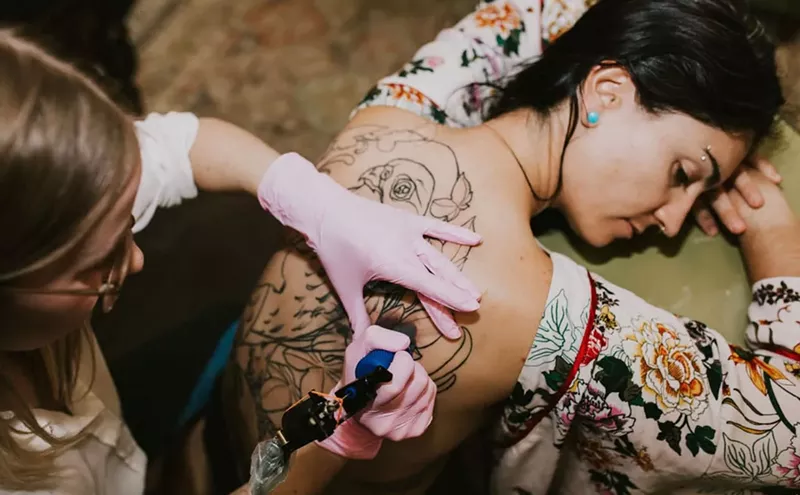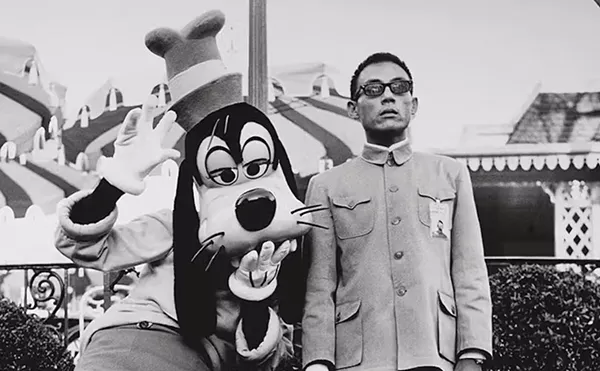One must wait, on humid days, for the file boxes at the Arizona State Archives to come to room temperature before handling their contents. The boxes are stored at 55 degrees to slow the aging of the fragile paper they contain. It's worth the wait, if what one is doing is looking objectively at an 83-year-old murder case that rocked the nation and put Phoenix on the map in a particularly terrible way. If one is there seeking clues that have been overlooked or deliberately concealed by previous reporters covering the case, the archives are a treasure trove of revelations, some of them blatantly obvious in their importance to this long-notorious case.
I've visited the archives many times before and since publishing a feature this past September about Winnie Ruth Judd, the notorious Phoenix "trunk murderess" who became internationally famous in 1931 after killing her two best friends, Anne LeRoi and Sammy Samuelson, dismembering one of them, shoving both bodies into several pieces of luggage, and taking them on the night train to L.A.
See also: Ruthless: A Long-Lost Confession Letter May Finally Tell the Real Story of Winnie Ruth Judd
Researching and writing the story changed what I thought I knew about the Judd case. After it was published, I heard from Judd scholars who wanted to talk about motives and from people who complained that I hadn't shared my own theory. Others wanted to share their theories: Ruth was part of a prostitution ring; she was out of town when the murders happened; she was covering for someone else who'd committed the crimes while she was at a party. This gruesome story, I discovered, hadn't lost its macabre luster.
"God," one of the archive librarians whispers to me during a recent visit. "Winnie Ruth Judd has always been one of our more popular collections. But after your story came out, it's been crazy. People are asking for her practically every day. But I can't tell you any names!"
I smile and nod. Ruth's story is always shrouded in secrets. And what would I do with names of people who want to read Ruth's trial depositions, to hold the anguished letters she wrote to her husband from prison, to ogle the bullets extracted from the bodies of her victims? My head is already filled with the oddly whimsical, almost Dickensian names in Ruth's own story: Ed Shimfissel. Viola Spickelmier. Avis Butchee. Harold Grimm. Fred Homberger.
Some of the names are comical enough to have been made up, and in fact, many of them are -- most notably those of the murderess and her two victims.
Everyone called Winnifred Judd by her middle name, Ruth. Anne's given name was Agnes; Sammy's was Sarah. All three were among a circle of party girls who kept company with local Phoenix businessmen, many of them married. Ruth became enamored of one of them, a philanderer named Jack Halloran who was also sleeping with Anne and Sammy. The best-known version of the story says that Ruth, jealous of her friends and angry at Anne's endless taunts about her time with Jack, quarreled with the women on October 16, 1931 at their bungalow home on North Second Street. Sammy, Ruth usually claimed, pulled a gun on her and, after a struggle, Ruth ended up killing both women in self-defense.
It's a story that crumbles after one reviews evidence and trial testimony stashed neatly away at the archives. It was there, a few years ago, that I came across a reference to a letter from Ruth to one of her attorneys, a letter I later found at the Arizona Historical Society Archives in Tucson. Written in her own hand in 1933, it told a version of the murders that differed from what's commonly known. It's a story Ruth told many times, one that got me to thinking about things I hadn't considered before, like whether she could have dismembered a body all by herself, and if so, when she'd done it, and where. It led me to want to write about my new theories on what likely happened in that Phoenix bungalow in October of 1931.
I am sitting on a sofa at Jack Halloran's house. My friend Sherry bought the cozy three-bedroom bungalow on Lynwood Street a few months ago, and she's hosting a holiday party tonight. One of Sherry's guests has plunked down beside me, demanding to know why I didn't tell readers about the supposed "prostitution ring" that Ruth and her victims may have belonged to.
"Okay," I am saying. "Halloran and his rich buddies liked to party with Ruth and her friends. And the girls were asked to introduce the guys to other women. And the guys brought gifts to the girls and sometimes helped them out financially. But that doesn't mean they were hookers."
"Oh, please," Sherry's pal groans. "They were party girls, and Halloran was their pimp!" She doesn't seem to know that we're at the late Mr. Halloran's former home, or that Anne LeRoi, one of Ruth's victims, had been arrested for "soliciting" at the Monroe Hotel shortly before her death. She doesn't know that many of the "party girls" lived in rental properties owned by the Halloran-Bennett Lumber Company, which Jack co-owned. And I don't bother to tell her. I came here tonight for an eggnog, not to rehash everyone's favorite local murder tale.
I'd been doing so for months, in person and via e-mail. Some readers grumbled that I didn't say definitively whether the victims were lesbian lovers. One Judd expert wrote that his research indicated that Ruth killed the two women after catching them in a three-way with Halloran. Some insisted that the newly discovered confession letter was bunk, that Ruth had written it to prove she was insane, or to exonerate Halloran so that he would come to her aid.
One woman wrote to ask me to help her publish patterns for the Winnie Ruth Judd rag dolls she had designed. A man in Alaska wanted to send the script for his shadow play, in which Ruth is depicted as an extraterrestrial prophet.
A lot of readers were angry. Why hadn't I just come out and said Ruth had killed in cold blood? Why hadn't I attempted to solve the case? How dare I even suggest that Winnie Ruth Judd had been anything other than a poor, put-upon young woman who got railroaded by our city's Good Old Boy network?
No one was more angry than former New Times editor Jana Bommersbach, who e-mailed that the confession letter I'd written about was inconsequential. Bommersbach, who hadn't responded to requests for an interview for my September article on Judd, is best known for her gorgeous and frankly misleading book The Trunk Murderess: Winnie Ruth Judd. She e-mailed that no one had ever heard of H.G. Richardson, the attorney to whom Ruth wrote her confession, proving that Bommersbach hadn't heard of him, at least. She claimed he was never one of Ruth's attorneys, although public record proves he was hired expressly to object to Ruth's trial attorneys' actions in court, and to obtain an appeal on her behalf, now on file at the state archives. (Asked for an interview for this article, Bommersbach replied, "So what other horrible crimes are you going to claim this poor woman did? I can see you accusing her of being the one who killed Don Bolles. Or maybe Bob Crane . . . No thanks . . .")
Bommersbach wrote that she had "predicted" the existence of such a letter in her book, published 20 years before the suppressed letter turned up at the state archives. She hadn't -- and how does one predict a letter, anyway? She also claimed I'd never read her book; if I had, she wrote, I'd have known about Halloran's attorney, A.N. Smith, requesting that Ruth write a letter exonerating him. I have read her book -- seven times. It was Bommersbach who hadn't bothered to read my writing on Judd; if she had, she'd have seen the paragraph about the A.N. Smith request in my story.
Bommersbach, a smart reporter and a fine writer, befriended Ruth while writing her book. By then, Judd was a sweet-natured granny who was going by yet another made-up name, Marian Lane. Ruth, Bommersbach came to believe, deserved a break. It didn't help that, as she admits in Trunk Murderess, Ruth just didn't want to talk anymore about having killed her friends 60 years earlier.
I could relate. I was sick of talking about Ruth Judd's tragic life myself. I could only imagine what it must have been like to live that life.
I am standing in the hallway of the murder cottage. The people who live in the Second Street home have allowed me inside, and I'm crouched in the hallway, staring into the bedroom where Anne was likely killed. The window frames are obscured by curtains; the kitchen is much closer to the bathroom than I'd always imagined. Otherwise, the house looks very much as it does in the many police-evidence photographs of the crime scene.
I'm looking around, trying to map out in my mind each of the versions of Ruth's murder tale. There's the official prosecution story, in which Ruth stood in this spot where I'm now standing, shooting her friends while they slept, chopping one up and stuffing both into luggage, then shooting herself in the left hand to bolster her fallacious self-defense story. There's Ruth's own self-defense story, in which she defends herself from an attack by both women (one of whom has chosen an ironing board as her weapon), killing both, then calling Halloran to come clean up the mess, which he does by calling in a mysterious third party to dismember Samuelson (usually, it's county physician Dr. Charles Brown, who may have also enjoyed the attentions of Halloran's gal pals). And there's the "second gunman" version, in which someone, presumably Halloran, turns up at the scene and kills one or both of the women after Ruth has either fainted or gone home.
Each of these stories is flawed, and yet all are entirely possible. Regardless of which scenario they believe, most folks insist that Ruth couldn't have acted alone, arguing that she was small in stature, sickly, and frail; she had a wounded hand; the dismemberment was too surgically precise. But the more one reads about Ruth Judd, the more one believes she could accomplish plenty, all by herself.
Ruth's spindly frame and poor health (she'd battled tuberculosis for years), suggested she lacked the stamina and strength to drag bodies to and from an empty packing trunk. Yet in her confession letter to Richardson, Ruth claims she was able to move them "an inch at a time" and that her highly excited state made it possible for her to perform feats of strength that otherwise would have been beyond her. And to believe that Ruth was too weak to have committed the crime negates her self-defense story, in which she overpowers two women, both larger than she. It disregards the week she spent on the run in Los Angeles, immediately following the crime. During that time, she didn't eat for days and had a gangrenous wound in her hand, yet managed to walk 20 miles from downtown Los Angeles to Pasadena.
She was certainly strong enough to cut up a dead body. Anyone who's read a true-crime book involving hacking up a corpse knows it's not as difficult as it may seem. Having worked in hospitals and sanitariums with her husband, Ruth had a more than passing knowledge of anatomy and where one might need to cut to remove a leg.
The oft-told story about Halloran calling Dr. Brown to come cut up Sammy doesn't wash. Dr. Wagner, an expert witness at Ruth's criminal trial, said the cuts were made with a sharp knife and not surgical equipment. Wouldn't a surgeon have brought along scalpels, or used the scalpels Ruth's husband had left in the house, later found in the trunk containing the bodies? Wagner claimed the cuts were irregularly made, which doesn't sound like the work of a professional surgeon. To be fair, Brown wasn't a surgeon; he was a county physician. He might have done as lousy a job as a layperson, cutting up a body.
Halloran's involvement at the crime scene seems unlikely. True, his gray Packard was seen there on the night of the murders, but he might just as well have been at the bungalow to get laid and not to somehow participate in covering up a murder. Wouldn't Halloran, a man who owned a fleet of flatbed trucks used for hauling lumber, simply have taken those bodies out to the desert and left them there? Would anyone with any sense have brought in a second witness (like Dr. Brown), then sent the injured and drug-addled Ruth on a 12-hour train ride to L.A. with no clear plan for dumping the bodies once she arrived there?
Much has been made of Ruth's hand injury, and how it would have prevented her from cutting up a body. Some believe she shot herself in the left hand to substantiate her self-defense story, but I believe Ruth's contention that her hand was injured during a scuffle with Sammy to gain control of the gun. But not her left hand; her right hand.
There is, as I wrote in my previous story, ample proof that Ruth's right hand was slightly injured during the fight with Sammy. But, according to Ruth's confession letter, she accidentally discharged the gun while washing her fingerprints off it on Sunday night, after the bodies had been packed. I believe this is how Ruth unintentionally injured her left hand, after dismembering Sammy and packing the bodies.
In all versions of the story, Ruth dismembers Sammy because she can't get both bodies to fit into the single steamer trunk at the North Second Street bungalow. But I don't believe she or anyone dismembered Sammy's body at the scene of the crime. I've become convinced that Ruth cut up Sammy at her apartment, after the trunk with both bodies was delivered there.
After pawing through hundreds of documents, I've found only one piece of reporting -- a story in the October 21, 1931 edition of the Los Angeles Evening Herald headlined "Truck Driver Tells Hauling Heavy Trunk" -- matching my theory that both bodies were still intact when they were transported from Second Street to Brill. But why would Ruth have cut up Sammy's body before placing it in the trunk, on top of Anne's? Ruth packed Sammy's body parts into several smaller pieces of luggage at her apartment, after the delivery man told her at the murder house that the railway would charge extra to transport such a heavy trunk. Repacking Sammy became necessary only once Ruth heard the trunk with both bodies was too heavy to ship. At Brill Street, Ruth only had smaller pieces of luggage, none of which were big enough to accommodate an entire body. She had no car with which to go purchase another larger trunk; if Halloran were involved in this take-the-bodies-to-L.A. scheme, as Ruth claimed, wouldn't he have simply gone and found a second trunk, large enough to fit another whole body?
One can argue that Ruth had to cut up Sammy because she was too heavy to lift into the trunk, but Ruth admits to having dragged the trunk from one end of her apartment to the other. She could have done so more easily with the weight of one body than with two. Or that it was impossible to fold Sammy's body into the trunk on top of Anne's, therefore making dismemberment -- so that parts of her could be stacked -- necessary.
Ruth claimed she didn't know that Sammy had been cut up before being placed in the trunk until she opened the trunk at Brill Street in order to "repack" Sammy's body. But how did she plan to fit Sammy's body, whole, into a hatbox, a carry-on, and a small steamer trunk when she opened the trunk at Brill Street? She either knew the body was dismembered or, more likely, decided to make Sammy fit by cutting her into pieces.
The most obvious reason that Sammy's body wouldn't fit into the trunk at the murder cottage would have been rigor mortis. In fact, Ruth writes in her confession letter, of Sammy, "I couldn't possibly lift her, she was too heavy her body was stiff." Rigor mortis typically sets in after about three or four hours, with a body reaching maximum stiffness after 12 hours. The stiffness dissipates usually about 24 hours after death.
If Halloran had called Dr. Brown to the scene, and the trio had determined that Sammy was too stiff to fold into the trunk atop Anne, wouldn't Brown have suggested waiting until rigor mortis was released, rather than the more gruesome choice of chopping the body into pieces to make it fit?
It's true that Dr. Wagner, at Ruth's criminal trial, stated that Sammy must have been dismembered more than an hour, but less than eight or nine hours, after her death. In her book, Bommersbach reports that the police decided Anne and Sammy were killed at 10:30 p.m. on Friday, and that medical experts concluded that Anne's body was placed into the trunk within six hours of her death, before rigor mortis set in.
But if Ruth killed the girls at about 6 a.m. on Saturday, as her confession letter suggests (a story that matches trial testimony from many, including Henry Behoteguy, a neighbor who lived kitty-corner from the murder house and heard shots and screaming just before 6 that morning), she could have packed both bodies into the trunk at the murder house and still made it to work by 10:30, which all accounts agree is when she arrived. The Lightning Delivery Company took the trunk with both bodies in it to Ruth's apartment on Brill late on Saturday night, and rigor mortis would have ended by early Sunday. If Ruth killed on Friday night, as much of the evidence suggests, that means both bodies would have been "soft" again by the time the trunk was delivered to Ruth's apartment.
I am sitting on a plastic office chair in what used to be the jail in the Maricopa County Courthouse. I'm not supposed to be here. A friend who's overseeing some repairs to the building has snuck me in to commune with the space where Ruth Judd was locked away in late 1931, awaiting her criminal trial.
After years of reading reams of testimony, trial transcripts and interviews, and hundreds of newspaper articles of the day, I'm sitting here thinking about what really happened on North Second Street in October 1931. And what I think is that Ruth Judd was in a crummy situation. Her husband was a drug addict; she was barely making ends meet; her boyfriend was sleeping with her two best friends, one of whom enjoyed teasing Ruth about it. She, a woman who soon would be diagnosed with a form of schizophrenia, chose self-medication. Luminal, an over-the-counter barbiturate used to calm epileptic seizures, blurred her mind and her ability to reason.
I think Ruth decided the only way to get Anne to stop teasing her was to kill her. She snuck into the Second Street bungalow after the girls went to bed and camped out on the sofa, as she writes in her April 6, 1933 confession letter, clutching a gun and trying to steel her courage. When she heard Sammy get up to go the bathroom, just before 6 a.m., she slipped into the bedroom and shot Anne. Sammy came out of the bathroom and took the gun from Ruth, then ran Ruth out of the house. Ruth eventually chased Sammy back in; they fought for the gun, which Sammy was still holding, and a bullet that jammed in the gun's chamber slightly injured Ruth's right hand. After which Ruth shot Sammy.
I think Ruth then dragged the large steamer trunk in from the garage, packed both girls into it, locked the front door of the house, and headed off to work at the Grunow Clinic with her right hand lightly bandaged. I believe she returned to the house that night, tidied up the house, emptied the contents of Anne's desk into the trunk, ditched the blood-stained mattress from Anne's bed, and hacked away a piece of blood-stained carpet under it, tossing it into the trunk. Then she called the Lightning Delivery Company, whose draymen told her the trunk was too heavy to send as luggage on the train she planned to take that night. She instructed the men to take the trunk to her apartment on Brill Street.
At this point, Ruth was out of money and out of ideas. I suspect she tried to phone Halloran for assistance, and when he didn't respond, she took matters into her own hands. I believe she dragged Sammy to the bathtub in her apartment, cut her legs off at the knees and chopped her torso in half, then packed the pieces into every piece of luggage she had in the house. (Bommersbach's book includes a compelling but unsubstantiated story in which a woman tells of her father, a plumber, cleaning out the drain in Ruth's apartment shortly after the murder. He found blood, skin, and bits of bone, the woman recalls, and the evidence was taken away by the police.) While Ruth was washing the fingerprints off the murder weapon, the gun went off, lodging a bullet in her left hand.
On that Sunday afternoon, she headed out to borrow money from friends for a train ticket to L.A. After scraping together train fare, she asked her landlord, Mr. Grimm, to take her and her gruesome pile of luggage to Union Station.
And then, Winnie Ruth Judd hopped on the night train headed for Los Angeles and rode straight into infamy.











